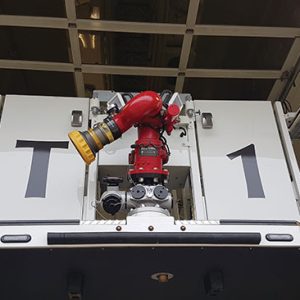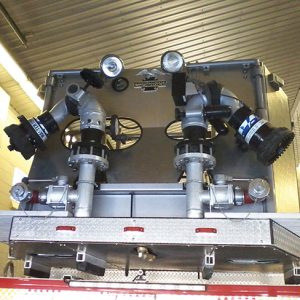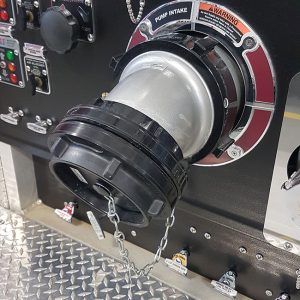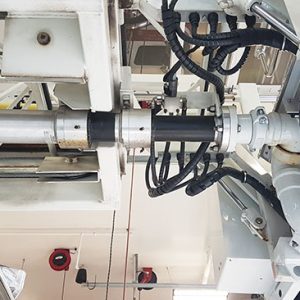
Features
Back to Basics: Flowing the aerial
April 18, 2022
By Mark van der Feyst
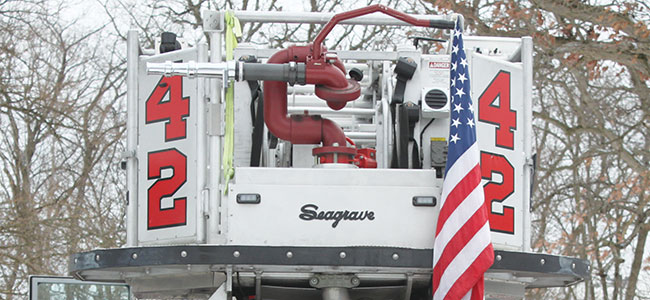 Photo 1: A smooth bore nozzle.
Photo 1: A smooth bore nozzle. This month’s article may not be applicable to every fire department within the country, but the principles will be. We are going to look at flowing water from the aerial master streams and the basics of doing so. Not every department has an aerial device, but they will have master streams that can be set up on the ground or even mounted on top of the engine or pumper.
Having an elevated master stream allows the fire department to flow water from above and direct the streams into the structure as needed. It is sort of like creating a rain shower for the structure but with a bit more force and quantity. In heavily populated areas, these devices are very useful as they can operate in narrow alleyways or around buildings will little clearance. The master stream can be elevated up and then directed wherever they need to go in a small geographical area. They are very beneficial and offer a great tactical advantage for structural fire attack.
Some aerial ladders will have different combinations of master streams affixed to the tip or platform. Some will have a single master stream and others will have a double master stream. In Photo 1, you will see an example of a single master stream with a smooth bore type of nozzle. This design is the simplest to use as there is just the pipe or waterway and the smooth bore tip. Affixed to it is a tiller bar to aid with directing the stream wherever it needs to go.
In Photo 2 you will see an example of another single master stream, but this is a combination type. In this case, it is an automatic combination nozzle. This type of set up is a little more complicated than the smooth bore type because there are more moving parts involved. There is still the waterway leading to the nozzle but inside the nozzle is where the other added components or parts are going to be. This particular model is also a remote-control type where the operator can be located on the ground and is able to direct the nozzle as needed with a remote-control device.
Photo 3 is an example of a double master stream set up. One master stream is a manual nozzle, and the other master stream is a remote-control operated nozzle. This set up is designed to deliver maximum water if needed based upon high target hazards within the response area.
Regardless of the type or master stream affixed to the aerial, whether single or double, they are going to flow a large volume of water. The range of water flow can be from 500 gpm up to 2500 gpm each with the average flow rate being around 1500 gpm. This is a large volume of water that is being pushed out or delivered onto or into the structure. As much as these master streams can flow, there is still a need for the supply of water to feed them. They will only flow volume based upon the amount of water being fed to them. What this means is you need to have a good water supply – both with volume and quantity.
Photo 4 is a side intake valve for an aerial device. This particular one is six inches or 150 mm in size. This is a large intake valve, but it allows for a larger volume of water to be delivered from the supply to the pump with less friction loss. Most aerial trucks will have a four inch or 100 mm intake valve which still provides adequate volume of water. The water source, usually a hydrant, will be utilized to supply the volume and quantity of water needed. In municipal settings, the water supply system can be boosted to assist with fire department operations.
To achieve maximum water supply on the hydrant, be sure to secure the high-volume hose to the largest port on it – this being the steamer port which is usually four inches. A hydrant can also be maximized by double tapping it with (two) four-inch hoses. The one will come directly off the steamer port and the other will come off the two and a half inch or 65 mm port. This will require using an adaptor to increase from the two and a half inches or 65 mm up to the four, five, or six-inch hose size. Double tapping the hydrant will deliver the volume needed to achieve target volumes on the master streams.
No matter what size intake or supply hose is being used, the “pipe” or waterway going up the aerial device is going to be one size only. In Photo 5, you will see an example of the pipe or waterway. The picture shows a four-inch or 100 mm waterway feeding the master streams. This is the standard size waterway used regardless of a single or double master stream set up on the tip or platform.
Now we have focused our attention on the aerial set up but as mentioned in the beginning, the principles are the same for other master stream set ups like on the ground or on top of a truck. The master streams will only flow what they are supplied with – this can include rural water operations.
The key to being able to flow water adequately from any master stream device is to actually do it – and not on the fire ground only! This is best done by training and getting to know the master stream set up on your aerial device. •
Mark van der Feyst has been in the fire service since 1999 and is currently a firefighter with the FGFD. Mark is an international instructor teaching in Canada, the United States, FDIC and India. He is the lead author of Fire Engineering’s Residential Fire Rescue & Tactical Firefighter books. He can be contacted at Mark@FireStarTraining.com.
Print this page
Advertisement
- Coming together for the Great Canadian Fire Census
- Q & A: Mandatory minimum certification for Ontario’s firefighters
